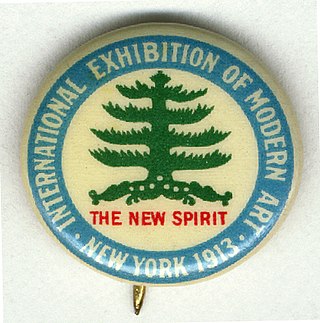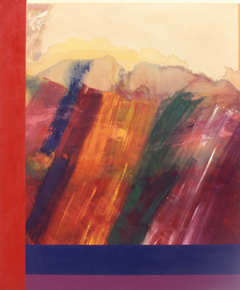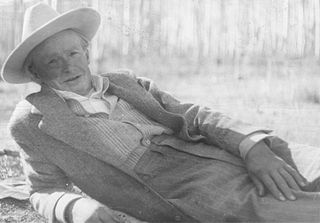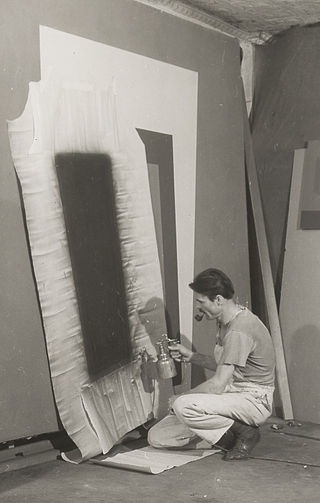Related Research Articles

Francis Picabia was a French avant-garde painter, writer, filmmaker, magazine publisher, poet, and typographist closely associated with Dada.

Abstract art uses visual language of shape, form, color and line to create a composition which may exist with a degree of independence from visual references in the world.

The 1913 Armory Show, also known as the International Exhibition of Modern Art, was organized by the Association of American Painters and Sculptors. It was the first large exhibition of modern art in America, as well as one of the many exhibitions that have been held in the vast spaces of U.S. National Guard armories.

Edward Stuart Davis was an early American modernist painter. He was well known for his jazz-influenced, proto-pop art paintings of the 1940s and 1950s, bold, brash, and colorful, as well as his Ashcan School pictures in the early years of the 20th century. With the belief that his work could influence the sociopolitical environment of America, Davis' political message was apparent in all of his pieces from the most abstract to the clearest. Contrary to most modernist artists, Davis was aware of his political objectives and allegiances and did not waver in loyalty via artwork during the course of his career. By the 1930s, Davis was already a famous American painter, but that did not save him from feeling the negative effects of the Great Depression, which led to his being one of the first artists to apply for the Federal Art Project. Under the project, Davis created some seemingly Marxist works; however, he was too independent to fully support Marxist ideals and philosophies.

Alexander Porfyrovych Archipenko was a Ukrainian-American avant-garde artist, sculptor, and graphic artist, active in France and the United States. He was one of the first to apply the principles of Cubism to architecture, analyzing human figure into geometrical forms.

Robert Henri was an American painter and teacher.

Synchromism was an art movement founded in 1912 by American artists Stanton Macdonald-Wright (1890–1973) and Morgan Russell (1886–1953). Their abstract "synchromies," based on an approach to painting that analogized color to music, were among the first abstract paintings in American art. Though it was short-lived and did not attract many adherents, Synchromism became the first American avant-garde art movement to receive international attention. One of the difficulties inherent in describing Synchromism as a coherent style is connected to the fact that some Synchromist works are purely abstract while others include representational imagery.

Nude Descending a Staircase, No. 2 is a 1912 painting by Marcel Duchamp. The work is widely regarded as a Modernist classic and has become one of the most famous of its time. Before its first presentation at the 1912 Salon des Indépendants in Paris it was rejected by the Cubists as being too Futurist. It was then exhibited with the Cubists at Galeries Dalmau's Exposició d'Art Cubista, in Barcelona, 20 April–10 May 1912. The painting was subsequently shown, and ridiculed, at the 1913 Armory Show in New York City.

John Marin was an early American modernist artist. He is known for his abstract landscapes and watercolors.

Ronnie Landfield is an American abstract painter. During his early career from the mid-1960s through the 1970s his paintings were associated with Lyrical Abstraction, and he was represented by the David Whitney Gallery and the André Emmerich Gallery.

Andrew Michael Dasburg was an American modernist painter and "one of America's leading early exponents of cubism".
Richard Jackson is an American contemporary artist born in 1939 in Sacramento. He now lives in Los Angeles, California.

Balcomb Greene (1904–1990) was an American artist and teacher. He and his wife, artist Gertrude Glass Greene, were heavily involved in political activism to promote mainstream acceptance of abstract art and were founding members of the American Abstract Artists organization. His early style was completely non-objective. Juan Gris and Piet Mondrian as well as Pablo Picasso and Henri Matisse influenced his early style. From the 1940s his work "opened out to the light and space of natural form." He painted landscapes and figure. "He discerned the pain of a man, and hewed to it integrally from beginning to end…. In his study of the figure he did not stress anatomical shape but rather its intuitive, often conflicting spirit."

John Dwyer McLaughlin was an American abstract painter. Based primarily in California, he was a pioneer in minimalism and hard-edge painting. Considered one of the most significant Californian postwar artists, McLaughlin painted a focused body of geometric works that are completely devoid of any connection to everyday experience and objects, inspired by the Japanese notion of the void. He aimed to create paintings devoid of any object hood including but not limited to a gestures, representations and figuration. This led him to the rectangle. Leveraging a technique of layering rectangular bars on adjacent planes, McLaughlin creates works that provoke introspection and, consequently, a greater understanding of one's relationship to nature.
Ralph Lewanda Wickiser (1910–1998) was an American artist. He is most notable for painting in the styles of both Abstraction and representation, and for synthesizing the two in his own innovative style.

Man on a Balcony, is a large oil painting created in 1912 by the French artist, theorist and writer Albert Gleizes (1881–1953). The painting was exhibited in Paris at the Salon d'Automne of 1912. The Cubist contribution to the salon created a controversy in the French Parliament about the use of public funds to provide the venue for such 'barbaric art'. Gleizes was a founder of Cubism, and demonstrates the principles of the movement in this monumental painting with its projecting planes and fragmented lines. The large size of the painting reflects Gleizes's ambition to show it in the large annual salon exhibitions in Paris, where he was able with others of his entourage to bring Cubism to wider audiences.

Man with a Pipe, also referred to as Portrait of an American Smoker, Portrait of an American Smoking, American Smoking and American Man, is a painting by the French Cubist artist Jean Metzinger. The work was reproduced on the cover of catalogue of the Exhibition of Cubist and Futurist Pictures, Boggs & Buhl Department Store, Pittsburgh, forming part of a show in 1913 that traveled to several U.S. cities: Milwaukee, Cleveland, Pittsburgh, New York, and Philadelphia.
Oli Sihvonen was a post-World War II American artist known for hard-edge abstract paintings. Sihvonen's style was greatly influenced by Josef Albers who taught him color theory and Bauhaus aesthetics at Black Mountain College in the 1940s. Sihvonen was also influenced by Russian Constructivism, Piet Mondrian, and Pierre Matisse. His work has been linked to Abstract Expressionism, Minimalism, Hard-Edge and Op-Art.

Norman Charles Zammitt was an American artist in Southern California who was at the leading edge of the Light and Space Movement, pioneering with his transparent sculptures in the early 1960s, followed in the 1970s by his large scale luminous color paintings.

Paul Herman Rohland was an American artist, printmaker, watercolorist, and muralist. He exhibited in the Armory Show of 1913 in New York City. Among others, his work is in the permanent collections of the Whitney Museum of American Art, the Barnes Foundation, National Museum of American Art-Smithsonian, the New Mexico Museum of Fine Arts, and the Woodstock Artists Association and Museum. He painted three post office murals for the Section of Painting and Sculpture.
References
This article includes a list of general references, but it lacks sufficient corresponding inline citations .(April 2009) |
Notes
- ↑ Shipp, Steve (1996). American Art Colonies, 1850-1930 . Westport, CT: Greenwood Press. p. 99. ISBN 0313296197.
- ↑ "Works – eMuseum". albuquerque.emuseum.com. Retrieved 2023-08-01.
- ↑ Lewandowski, Stacia (2011). Light, Landscape and the Creative Quest : Early Artists of Santa Fe. Santa Fe, NM: Salska Arts. p. 53. ISBN 9780615469171.
Sources
- "Unprized Prizewinner". Time Magazine. Dec. 31, 1945.
- Myers, Bernard: The Painting of Paul Burlin, "Perspectives". Washington University in St. Louis, Spring 1954.
- HIS: Armory Show Veteran at Alan Gallery. "Art News", 57:11, February 1958.
- "102 Artists to Wax Enthusiastic About". Time Magazine. July 6, 1962.
- Whitney, George. Abrupt Ending: The Work of Paul Burlin. Arts. Sept. 1981, p. 97.
- Filreis, Alan. "Beyond The Rhetorician's Touch": Stevens's Painterly Astractions, American Literary History, Spring 1992, pp. 230–63.
- Wedell, Eugene. "Paul Burlin Catalog", Burlin Art Trust, 2008.